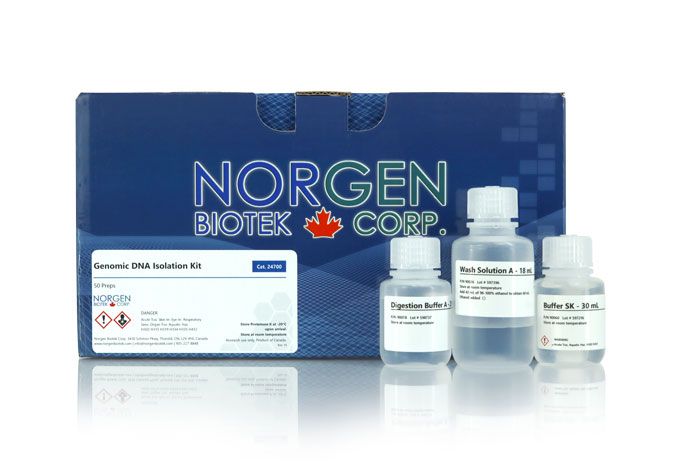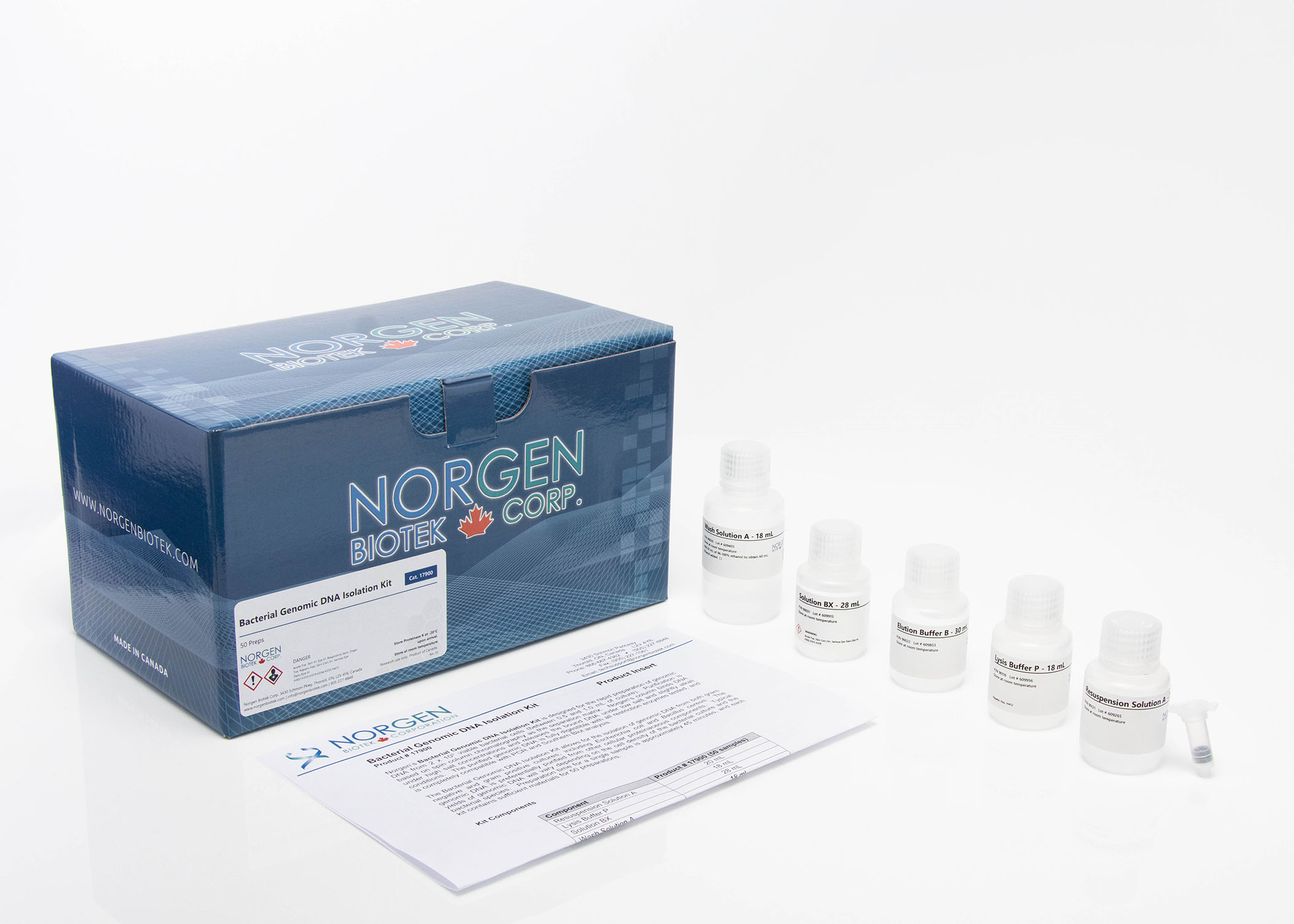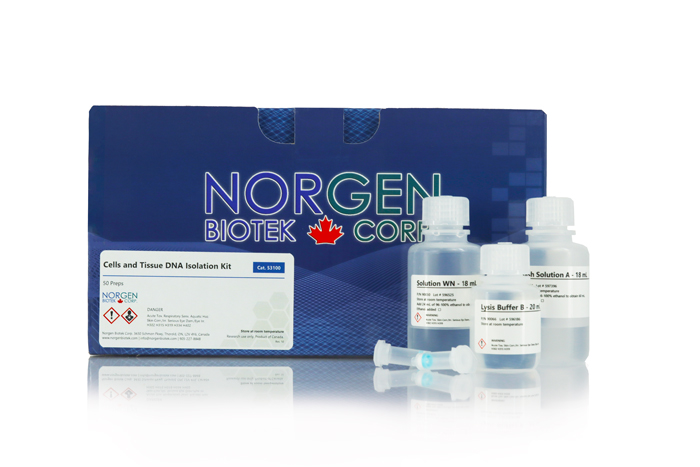Genomic DNA Isolation Kit
For the isolation of genomic DNA from animal tissues, cells, bodily fluids, virus and swabs

For research use only and NOT intended for in vitro diagnostics.
Genomic DNA Isolation Kit
For the isolation of genomic DNA from animal tissues, cells, bodily fluids, virus and swabs
Features and Benefits
- Isolate genomic DNA from animal tissues, cells, bodily fluids, viruses and swabs
- Rapid and convenient spin column procedure
- Purified DNA is of the highest quality and integrity for sensitive downstream applications including PCR, qPCR, genotyping, sequencing and more
This kit is designed for the rapid preparation of genomic DNA from various tissue samples, cultured cells, viruses, bodily fluids and swabs using a rapid spin column protocol. Purified DNA is of an excellent yield and quality, and is immediately ready for any downstream application including PCR, qPCR, genotyping, sequencing and more. The protocol can be completed in approximately 80 minutes (including incubation time).
Details
Supporting Data
Figure 1. Isolation of High Quality Genomic DNA. Genomic DNA was isolated from various sample types using Norgen's Genomic DNA Isolation Kit. Lanes 1-3 contain genomic DNA that was isolated from four different samples containing 5 x 105 HeLa cells, while lanes 4 and 5 contain genomic DNA that was isolated from 5 mg of heart tissue. All the purified genomic is of the highest quality and integrity. Lane M is the Norgen HighRanger 1kb DNA Ladder. For all purified DNA, 10 µL of each 200 µL elution were resolved on a 1X TAE, 1% agarose DNA gel.
Figure 2. Full Compatibility with Digests. Genomic DNA was isolated from 10 mg of kidney tissue using Norgen's Genomic DNA Isolation Kit, and subsequently digested. Twenty microliters of the 200 µL eluted DNA were used in a 50 µL restriction digestion with 10 units of either Hind III or Nde I (overnight at 37°C). Fifteen microliters of the digested DNA were then loaded on a 1X TAE, 1% agarose gel. Lane 1 contains undigested Norgen-isolated DNA, while Lanes 2 contain the genomic DNA digested with Hind III and Lanes 3 contain the genomic DNA digested with Nde I. Lane M is Norgen's HighRanger 1kb DNA Ladder.
|
Kit Specifications
|
|
| Column Binding Capacity |
25 µg
|
| Average Yield:* HeLa Cells (1 x 106) Tissue (from 10 mg kidney) |
8 µg 10 µg |
| Maximum Amount of Starting Material: Animal Tissues Cultured Cells Bodily Fluids (blood, saliva) Viral Suspension |
20 mg 3 x 106 cells 150 µL 150 µL |
| Time to Complete 10 Purifications |
80 minutes
|
* Yield will vary depending on the type of sample processed
Storage Conditions and Product Stability
The Proteinase K should be stored at -20°C upon arrival and after reconstitution. All other solutions should be kept tightly sealed and stored at room temperature. This kit is stable for 2 years after the date of shipment.
| Component | Cat. 24700 (50 preps) | Cat. 24750 (100 preps) | Cat. 24770 (250 preps) |
|---|---|---|---|
| Digestion Buffer A | 25 mL | 2 x 25 mL | 5 x 25 mL |
| Buffer SK | 30 mL | 2 x 30 mL | 5 x 30 mL |
| Wash Solution A | 18 mL | 2 x 18 mL | 5 x 18 mL |
| Elution Buffer B | 30 mL | 2 x 30 mL | 5 x 30 mL |
| Proteinase K | 12 mg | 2 x 12 mg | 5 x 12 mg |
| Spin Columns | 50 | 100 | 250 |
| Collection Tubes | 50 | 100 | 250 |
| Elution Tubes (1.7 mL) | 50 | 100 | 250 |
| Product Insert | 1 | 1 | 1 |
Documentation
FAQs
Spin Column
Column clogging may occur due to the sample being too large. Do not exceed the recommended amount of starting materials. The amount of starting material may need to be decreased if the column shows clogging below the recommended levels. Clogging can also be alleviated by increasing the g-force and/or centrifuging for a longer period of time until the lysate passes through the column.
Lysate can be more gelatinous prior to loading onto the column due to the following factors:
- The lysate solution mixture is not homogeneous. To ensure a homogeneous solution, vortex for 10-15 seconds before applying the lysate to the spin column.
- Maximum number of cells or amount of tissue exceeds kit specifications. Refer to specifications to determine if the amount of starting material falls within kit specifications.
A low genomic DNA yield may be caused by:
- Improper storage of samples. Tissue samples and cell pellets may be frozen and stored at -20°C or -70°C. Repeated freezing and thawing of stored samples should be avoided, as this may lead to decreased yields of DNA.
- Incomplete lysis of cells. Extend the incubation time of Proteinase K digestion or reduce the amount of tissue or cells used for lysis.
- The DNA elution is incomplete. Ensure that centrifugation at 14,000 x g is performed after the 3,000 x g centrifugation cycle, to ensure that all the DNA is eluted.
Shearing of genomic DNA can be due to the following reasons:
- The genomic DNA was handled improperly. Pipetting steps should be handled as gently as possible. Reduce vortexing times during mixing steps (no more than 10-15 seconds).
- Improper storage of sample. Repeated freezing and thawing of stored samples should be avoided as this may lead to decreased DNA size.
- The sample is old. Sheared DNA may be obtained from old tissue or cell samples. Fresh samples are recommended for maximum genomic DNA yield.
Yes, mitochondrial DNA (mtDNA) can be successfully isolated using this kit. Please contact our Tech support team at support@norgenbiotek.com and ask for reference publications.
Citations
| Title | A54T polymorphism in the fatty acid binding protein 2 studies in a Saudi population with type 2 diabetes mellitus |
| Citation | Lipids in Health and Disease 2023. |
| Authors | KK Alharbi, IA Khan, MD Bazzi, NM Al-Daghri, TN Hasan, MS Alnbaheen, FK Alharbi, R Syed, MAM Aboul-Soud |
| Title | Aberrant DNA Methylation of Matrix Remodeling and Cell Adhesion Related Genes in Pterygium |
| Citation | Plos One February 2011 | Volume 6 | Issue 2 | e14687 2023. |
| Authors | Andri K. Riau1, Tina T. Wong1,2,3,4, Sharon N. Finger1, Shyam S. Chaurasia1, Ai Hua Hou1, Silin Chen1, Shang Juan Yu1, Louis Tong1,2,5* |
| Title | Agrobacterium Transformation of Tea Plants (Camellia sinensis (L.) KUNTZE): A Small Experiment with Great Prospects |
| Citation | Plants 2023. |
| Authors | Anastasia Fizikova 1,2,*ORCID,Elena Subcheva 1ORCID,Nikolay Kozlov 3ORCID,Varvara Tvorogova 1,3,Lidia Samarina 1,2,*,Ludmila Lutova 1,3 andElena Khlestkina 1,4 |
| Title | Antigenic distribution of Streptococcus agalactiae isolates from pregnant women at Garankuwa hospital - South Africa |
| Citation | Germs 2023. |
| Authors | Martina O Chukwu1 , Rooyen Tinago Mavenyengwa2*, Charles M Monyama3 , John Y Bolukaoto4 , Sogolo L Lebelo5 , Motlatji RB Maloba6 , Maphoshane Nchabeleng7 , Sylvester Rogers Moyo |
| Title | Apolipoprotein C3 Gene Variants and Risk of Developing Type 2 Diabetes in Saudi Subjects |
| Citation | Metabolic Syndrome and Related Disorders 2023. |
| Authors | Alharbi Khalid K., Hussain Tajamul, Alharbi Fawiziah K., Tabassum Shaik Nazia, Mohammed Arif A., Gambhir Dikshit, and Ali Khan Imran |
| Title | Association of angiotensin converting enzyme gene insertion/deletion polymorphism and familial hypercholesterolemia in the Saudi population |
| Citation | Lipids in Health and Disease 2023. |
| Authors | KK Alharbi, TS Kashour, W Al-Hussaini, MS Al-Nbaheen, S Mohamed, RMW Hasanato, W Tamimi, MY Al-Naami, IA Khan |
| Title | Association of azoospermia factor region deletions in infertile male subjects among Malaysians |
| Citation | Andrologia 2023. |
| Authors | AA Hussein, R Vasudevan, I Patimah, N Prashant, FA Nora |
| Title | Barcode Sequencing Screen Identifies SUB1 as a Regulator of Yeast Pheromone Inducible Genes |
| Citation | G3: Genes, Genomes, Genetics 2023. |
| Authors | Sliva, A., Kuang, Z., Meluh, P. B., & Boeke, J. D |
| Title | Clonal architecture of chronic myelomonocytic leukemias |
| Citation | Blood 2023. |
| Authors | Raphael Itzykson, Olivier Kosmider, Aline Renneville, Margot Morabito, Claude Preudhomme, Celine Berthon, Lionel Ades, Pierre Fenaux, Uwe Platzbecker, Olivier Gagey, Phillipe Rameau, Guillaume Vainchenker, Nathalie Droin, Eric Solary |
| Title | Comparing Natural and Artificially Designed Bacterial Consortia as Biosensing Elements for Rapid Non- Specific Detection of Organic Pollutant through Microbial Fuel Cell |
| Citation | Int. J. Electrochem. Sci 2023. |
| Authors | Anam, M., Yousaf, S., Sharafat, I., Zafar, Z., Ayaz, K., & Ali, N |


